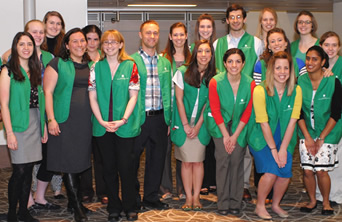Last updated: November 22, 2013
Students explore the natural world during DNA Day activities
Students explore the natural world during DNA Day activities
By Omar McCrimmon
Assistant Public Affairs Specialist
 |
On a partly cloudy morning in Washington, D.C., excited high school students chattered about National DNA Day activities in the lobby of the world's largest museum and research facility. Taba Sumkhan, 15, and Kimberly Pena, 16, from Magruder High School in Rockville, Md., were eager to visit the Smithsonian Institution's National Museum of Natural History (NMNH) on a rare field trip.
They enjoyed a break from regular class work but, more importantly, they were looking forward to learning directly from scientists about DNA and how it relates to the natural world. They were just two of the 300 middle and high school students who spent April 19, 2013, celebrating National DNA Day at the museum.
National DNA Day commemorates the discovery of DNA's double helix by Drs. James Watson and Francis Crick in 1953; but this year was special since the day also coincided with the 10th anniversary of the Human Genome Project completion in 2003.
The day started out with a panel discussion in the museum's Baird Auditorium. Students paid rapt attention as genomic scientists described their interest in science and the steps they took to develop their careers. Panelists included:
- Keisha Findley, Ph.D., NHGRI health disparities post-doctoral fellow, Genetics and Molecular Biology Branch
- Jeff Schoenebeck, Ph.D., NHGRI comparative biology fellow, Cancer Genetics Branch
- Debra Regier, M.D., Ph.D., NHGRI clinical geneticist, Undiagnosed Diseases Program
- Lauren Doyle, M.G.C., University of Maryland Genetic Counselor
"It was really cool to hear about how they got to where they are in their career," said Mitchell Gillin, 16, from Governor's School at Innovation Park in Manassas, Va. "Someday, I hope to get into the field of bioinformatics, so I was very eager to hear what the panelists had to say."
After the discussion, more than 30 students lined up all the way to the back of the auditorium to ask panelists burning questions. A lot of the students wondered how the panelists balanced their social lives while getting their advanced degrees.
""Make time for some fun," advised Lauren Doyle, a University of Maryland genetic counselor. "It makes a huge difference."
Genome: Unlocking Life's Code, opening June 14 at the museum. There, they participated in the 'genes in a bottle' activity, in which students create a personal DNA sample from their own saliva that they put in a vial and wore on a cord around their necks.
"I can't wait to show my parents this necklace when I get home and tell them how I extracted my own DNA," Ms. Pena said.
The students received clues to the museum scavenger hunt and searched for answers in exhibits related to evolution, DNA and human origins. Clues like, "Genomics has been used to determine that sea cows are more closely related to ________ than to seals or whales," sent students racing to complete the scavenger hunt assignment. For each completed task, they received a sticker to put in their genomic passport.
NMNH employees and genetic counselors wearing bright neon yellow and green vests stood at different parts of the museum in case students needed guidance. The students followed clues to the Sant Ocean Hall, the Eternal Life in Ancient Egypt exhibition and the African bull elephant in the museum rotunda.
"It's been a lot fun running through the museum looking for clues," said Ms. Sumkhan."I was pretty surprised how human life is so connected to our natural surroundings." The students then headed over to the "Qurious" lab, an educational facility within the museum that will open soon. They previewed hands-on activities that will be a part of the exhibition Genome: Unlocking Life's Code, opening June 14 at the museum. There, they participated in the 'genes in a bottle' activity, in which students create a personal DNA sample from their own saliva that they put in a vial and wore on a cord around their necks.
After the scavenger hunt, students watched the Coral Reef Adventure, an IMAX documentary film, which follows the real-life expedition of ocean explorers and underwater filmmakers Howard and Michele Hall. In the film, the Halls documented the health and beauty of coral reefs in South Pacific islands.
At the end of the busy day, NHGRI and NMNH educators encouraged students and their teachers to return to visit the upcoming exhibition for a high-tech, high-intensity experience on what genomic research has accomplished, where the field is going and how it will affect their health. (http://www.mnh.si.edu/exhibits/genome/)
"For us, National DNA Day has been an opportunity to connect scientists with students and get them excited about the possibilities that exist within genetics and genomics," said Carla Easter, Ph.D., deputy chief in NHGRI's Education and Community Involvement Branch. "We think everybody should celebrate National DNA Day."